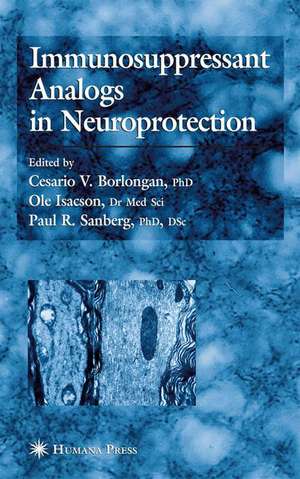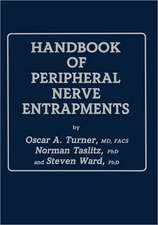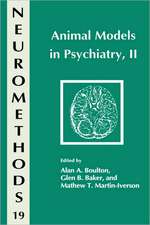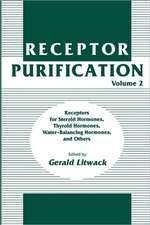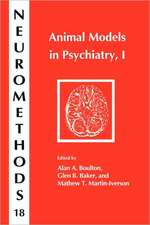Immunosuppressant Analogs in Neuroprotection
Editat de Cesario V. Borlongan, Ole Isacson, Paul R. Sanbergen Limba Engleză Hardback – 20 noi 2002
| Toate formatele și edițiile | Preț | Express |
|---|---|---|
| Paperback (1) | 784.28 lei 6-8 săpt. | |
| Humana Press Inc. – 3 dec 2012 | 784.28 lei 6-8 săpt. | |
| Hardback (1) | 1108.51 lei 6-8 săpt. | |
| Humana Press Inc. – 20 noi 2002 | 1108.51 lei 6-8 săpt. |
Preț: 1108.51 lei
Preț vechi: 1166.84 lei
-5% Nou
Puncte Express: 1663
Preț estimativ în valută:
212.10€ • 221.48$ • 175.15£
212.10€ • 221.48$ • 175.15£
Carte tipărită la comandă
Livrare economică 15-29 aprilie
Preluare comenzi: 021 569.72.76
Specificații
ISBN-13: 9780896039445
ISBN-10: 0896039447
Pagini: 378
Ilustrații: XXVII, 378 p.
Dimensiuni: 155 x 235 x 27 mm
Greutate: 0.77 kg
Ediția:2003
Editura: Humana Press Inc.
Colecția Humana
Locul publicării:Totowa, NJ, United States
ISBN-10: 0896039447
Pagini: 378
Ilustrații: XXVII, 378 p.
Dimensiuni: 155 x 235 x 27 mm
Greutate: 0.77 kg
Ediția:2003
Editura: Humana Press Inc.
Colecția Humana
Locul publicării:Totowa, NJ, United States
Public țintă
Professional/practitionerCuprins
I: Immunosuppressants, Neurologic Disorders, and Neuroprotection.- 1 • Introduction: Immunosuppressants as Neuroprotective Agents.- II: Immunosuppressants and Parkinson’s Disease.- 2 • Cyclosporin-Mediated Amelioration of Degeneration of Dopaminergic Neurons in Experimental Models of Parkinsonism.- 3 • Immunophilin Ligands and Dopamine Neurons: Specific Effects in Culture and In Vivo.- 4 • Effects of Neuroimmunophilin Ligands on Parkinson’s Disease and Cognition.- 5 • Improved Survival of Grafted Dopamine Neurons by Calcineurin Inhibitors.- 6 • Possible Mechanisms Underlying the Protective Action of Immunosuppressants Against Parkinson’s Disease: The Mitochondrial Permeability Transition Pore Hypothesis.- III: Immunosuppressants and other Age-Related Disorders.- 7 • Immunosuppressants and Alzheimer’s Disease.- 8 • Cyclosporin A Protects Striatal Neurons from Mitochondrial Dysfunction: Implications for Huntington’s Disease.- IV: Immunosuppressants, Stroke, and Traumatic Brain Injury.- 9 • Cyclosporin A Protects Mitochondria in an In Vitro Model of Hypoxia/Reperfusion Injury.- 10 • Protective Effect of Cyclosporin A on Glial Activation and White Matter Alterations Induced by Chronic Cerebral Hypoperfusion.- 11 • Blockade of Late-Onset Reduction of Muscarinic Acetylcholine Receptors by Immunosuppressants in Forebrain Ischemia.- 12 • The Role of Immunophilins in Focal Cerebral Ischemia: Evidence of Neuroprotection by FK506.- 13 • Immunosuppressants in Traumatic Brain Injury.- V: Immunosuppressants and Spinal Cord Injury.- 14 • Inhibition of Lipid Peroxidation by Cyclosporin After Spinal Cord Injury in Rats.- 15 • Axonal Regeneration in Cyclosporin A-Treated Rats Submitted to Transverse Section of the Spinal Cord.- VI:Immunosuppressants and Sciatic Nerve Injury.- 16 • Neuroimmunophilin Ligands Accelerate and Promote Nerve Regeneration in the Rat Peripheral Nerve and Spinal Cord: Role of the Steroid Receptor—FKBP52 Complex.- 17 • Neuroimmunophilin Ligands Stimulate Recovery of Injured Sciatic Nerves.- VII: Immunosuppressants and other Disorders of the Central Nervous System.- 18 • Cyclosporin A Prolongs Survival of SOD1 Mutant Mice and Implicates Mitochondrial Permeability Transition in Amyotrophic Lateral Sclerosis.- 19 • Psychological Effects of Cyclosporin A.
Recenzii
Forerword by Solomon H. Snyder
Textul de pe ultima copertă
In recent years there has been a growing recognition that such widely used immunosuppressant drugs as cyclosporin and FK-506 and their analogs-the neuroimmunophilins-possess significant neurotrophic and neuroprotective properties in addition to their beneficial effects for transplant patients. In Immunosuppressant Analogs in Neuroprotection, pioneers in the field and leading neuroscientists and clinicians working with these drugs survey the most recent scientific evidence showing how they evolved from being purely immunosuppressant "drugs" to neuroprotective "agents." These authorities focus on recent preclinical evidence that demonstrates the neurotrophic/neuroprotective effects of immunosuppressants when administered alone or when combined with neural transplantation therapy in animal models of neurological disorders. They discuss their efficacy and mechanisms of action in vitro and in vivo; using these models of CNS disease, they report laboratory studies with compelling clinical indications for Alzheimer's disease, Huntington's disease, stroke, traumatic brain injury, spinal cord injury, ALS, sciatic nerve injury, and drug addiction. They also present novel hypotheses on the mechanisms of neuroprotection, ranging from the blockade of mitochondrial permeability transition pores to free radical scavenging to the inhibition of calcineurin.
Authoritative and cutting-edge, Immunosuppressant Analogs in Neuroprotection demonstrates that CsA, FK-506, and the immunophilins exert neuroprotective effects on their own and will serve well as a new breed of neuroprotective agents for the treatment of neurological disorders.
Authoritative and cutting-edge, Immunosuppressant Analogs in Neuroprotection demonstrates that CsA, FK-506, and the immunophilins exert neuroprotective effects on their own and will serve well as a new breed of neuroprotective agents for the treatment of neurological disorders.
Caracteristici
Includes supplementary material: sn.pub/extras
